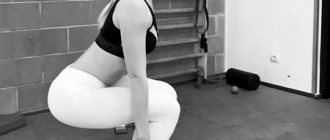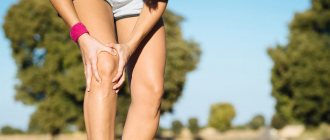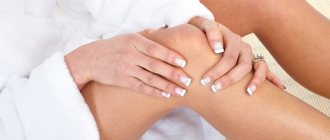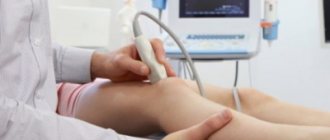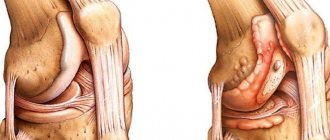Acute knee pain
Acute pain in the knee occurs immediately after a traumatic impact, a few days after the injury (usually in the morning) or some time after an infection. Injury can occur even during everyday activities - its risk is increased by excess weight, bad habits, and professions associated with carrying heavy loads.
Bruises
With a bruise (may be accompanied by a blue, purple or purple bruise or pinpoint hemorrhages), the tissues swell due to the accumulation of exudate, and their nutrition is disrupted. Since the knee joint is practically not protected by soft tissues, its bruises are very painful and dangerous. Knee pain due to a bruise can signal damage to the cartilage tissue and periosteum, bone microcracks and other serious problems. Therefore, if pain occurs, it is very important to go to the emergency room within 1-2 days after the injury, even if the pain is not too intense.
Bruises are characterized by severe sharp pain in the knee when pressed, noticeable swelling or hematoma. Sensations in the area of the knee joint can be bursting and pressing. If the knee “shoots”, an inflammatory process is likely - it should be stopped by an orthopedist-traumatologist.
Sprains
The causes of severe knee pain sometimes lie in a sprain that went unnoticed. If there is excessive tension or tension in the muscles, ligaments, tendons, the symptoms may resemble a bruise (accumulation of exudate, pain when pressing, limited mobility in the knee, hematoma). But the nature of the pain is already shooting, sharp. There is also instability in the knee when stepping on the sore leg - the joint seems to wobble. When sprained, the symptoms increase very quickly.
Tears and tears
With sudden braking, eversion of a limb, or a directed impact, the ligaments that provide normal mobility in the joint can be torn off. Often a characteristic pop is heard. The leg quickly swells within an hour, increasing in size by 2 times, the victim feels a sharp pain in the knee. After using decongestants, abnormal mobility of the knee joint becomes noticeable. This condition requires professional treatment!
Meniscus tear
An injury typical of athletes, which most often occurs when the leg is bent and simultaneously everted at the knee joint. The pain is usually felt on the inside of the knee. There is a clear hemorrhage, serious swelling, and the injured person cannot bend his leg at the knee. The patient may require immediate surgery to repair the meniscus.
Causes
When your knees hurt when squatting, you need to look for the reasons quickly. The correctness of subsequent treatment will depend on the clearly identified etiology of the problem.
- Injuries are the main reason. Falls, accidents, sports training, in some cases even from household chores, knees hurt when squatting and standing up.
- Bursitis is also a common condition that causes your knees to hurt when you stand up and sit down. Inflammation of the joint capsule itself causes pain, and if the joint is partially destroyed due to disease, then the pain can intensify many times over.
- When a ligament is sprained or torn, a person understands, “I can’t squat, my knees hurt.” This is an extremely serious injury that requires immediate medical attention.
- A meniscus injury is also one of the most common causes of knee discomfort. These injuries are most common among athletes, especially those involved in weightlifting, as their meniscus wears out faster.
Chronic knee pain
Chronic pain is characterized by a gradual increase in pain. The rate of its progression can vary from several months to several years. Initially, pain in the knee when bending occurs after a long stay in the same position, after sleep, at the very beginning or after physical activity (warm-up is required). The causes of such pain are usually inflammatory or degenerative in nature.
The causes of knee pain depend on the nature of its occurrence.
Osteoarthritis of the knee joint
With osteoarthritis, the inflammatory process in the joint capsule spreads to the heads of the bones. The cartilage in the knee joint wears down and thins, causing the heads of the bones to no longer slide smoothly through the knee when flexing and extending.
With this disease, joint effusion is formed, which interferes with healthy movement along with bone friction. Osteoarthritis of the knee can occur due to genetic causes, trauma (for example, improperly treated ligament damage), and other reasons.
Rheumatoid arthritis
The cause of knee pain in this autoimmune disease is that the body's defense cells attack its own tissues. When the synovial membrane of the knee joint is damaged, the knee loses mobility, swells, becomes hot, and hurts. Patients also experience increased fatigue, loss of appetite, and general body temperature may rise (to low-grade fever and higher).
With rheumatoid arthritis, a feeling of stiffness and other unpleasant symptoms are especially noticeable in the morning, immediately after waking up. This disease requires lifelong basic therapy and observation by a rheumatologist.
Patellofemoral pain syndrome
This problem often worries young people (especially women). There are no structural changes in the knee joint, but the kneecap may move forward with increased physical activity. The cause of patellofemoral pain can be incorrect position of the foot (congenital and acquired), excessive loads - when the muscles are not developed enough to perform the exercise.
Other causes of knee pain include bursitis and synovitis, ligamentitis and tendinitis (inflammation of the bursa, ligament and tendon, respectively). They are characterized by sharp pain. The patient may also be worried about gout, neuropathy or problems with the lumbosacral spine, cysts, oncology and other diseases. Remember: only a rheumatologist can adequately assess symptoms after diagnostic studies. He can prescribe minimal maintenance therapy for 2-3 weeks (with spontaneous recovery possible), or formulate a long-term treatment strategy for a continuous or recurrent course.
A little about the knee
The knee joint is a joint that connects the patella, femur and tibia (roughly speaking, thigh, tibia and kneecap). It consists of cartilages, menixes, collateral ligaments, etc. The structure is really very complex.
This entire “mechanism” is placed in an articular capsule (also called a joint capsule), inside which a special fluid is produced. This fluid nourishes and moisturizes the joint, minimizes friction and protects the entire cartilage complex from mechanical damage.
If any of the above fails, a person will have difficulty squatting, let alone doing squats in the gym.
Diagnosis of knee pain
Before treating knee pain, you need to have its cause determined by your doctor. Making a diagnosis of knee pain begins with a verbal interview with the patient and collection of anamnesis. It is important to establish whether the patient suffered an injury or infection shortly before the onset of pain, whether there are accompanying symptoms, and under what conditions the pain is especially severe. Also during the initial examination, the doctor may palpate the area that is causing concern and perform motor tests (for example, knee flexion-extension) to assess the extent of the pathological process.
Competent diagnosis helps to correctly prescribe treatment
If you are worried about knee pain, which doctor should you contact? First of all, see an orthopedist-traumatologist or rheumatologist. They will draw up an examination plan and, if necessary, refer you to another doctor.
To confirm the preliminary diagnosis, symptoms and treatment of knee pain, specialists prescribe one or more studies:
- X-ray;
- Ultrasound;
- MRI;
- arthroscopy (minimally invasive diagnostic surgery);
- puncture to collect synovial fluid.
Diagnosis
If a specialized specialist complains of pain in the knee joint during flexion and extension, he conducts an initial examination of the patient. The initial examination includes the following procedures:
- patient interview;
- viewing a medical record;
- visual inspection;
- palpation;
- issuing referrals for tests and research.
As part of a diagnostic examination, the patient is required to follow the doctor’s instructions - tests and studies guarantee the truth of the diagnosis and the correctness of treatment tactics. As usual, the list of necessary diagnostic measures is as follows:
- blood analysis;
- Analysis of urine;
- X-ray examination;
- MRI;
- CT;
- Ultrasound;
- arthroscopy of the knee joint.
The last type of study is invasive and is prescribed exclusively when other methods are powerless or there is suspicion of a serious pathology of the knee joint.
Treatment for knee pain
Treatment of knee pain requires an integrated approach, which includes drug therapy, physiotherapy (including therapeutic exercises to strengthen muscles), general health improvement and wearing special orthoses. These can be elastic bandages, knee pads, splints and other devices that help relieve the knee, prevent re-injury due to abnormal mobility and speed up rehabilitation.
Treatment of knee pain requires a comprehensive approach
Treatment for knee pain with medications
For the treatment of knee pain, non-steroidal anti-inflammatory drugs (NSAIDs), glucocorticoids, chondroprotectors and vasodilators play a major role. Specialists prescribe simple analgesics with caution, because... they do not allow the attending physician and the patient to assess the condition of the knee; patients do not comply with a gentle regimen.
Different groups of medications are used to treat knee pain
Anti-inflammatory drugs for knee pain
Relieving inflammation and pain is one of the primary tasks for lesions in the knee area. For this, local and systemic NSAIDs (ointments and tablets for knee pain) are used.
Their active ingredients: ibuprofen, indomethacin, diclofenac, nimesulide, celecoxib, meloxicam, ketoprofen, lornoxicam, ketorolac and others. All these drugs can be purchased in tablets.
For aching pain, patients are given injections for knee pain: meloxicam, arthrozan, diclofenac, ortofen.
For mild to moderate pain, NSAIDs can be prescribed as ointments for pain in the knee joints. The most accessible of them: dollit, voltaren, fastum gel, artrosilene, finalgon, ketonal, indomethacin. For knee injuries, medications with heparin are recommended. To relieve swelling - with dimexide (also in the form of compresses, if the component does not cause irritation to the skin).
If NSAIDs are ineffective and the patient continues to experience excruciating pain, the attending physician selects a glucocorticosteroid drug for him (for example, diprospan, hydrocortisone, prednisolone, Kenalog) in the form of tablets or intra-articular injections.
Chondroprotectors
Whatever disease provokes discomfort in the knee, doctors recommend the use of chondroprotectors with glucosamine and chondroitin for therapeutic and preventive purposes. The use of these drugs accelerates the regeneration of connective tissue, in particular cartilage, protects it from oxidative shock, and promotes the growth of healthy chondrocytes. Chondroprotectors have a positive effect on the rate of rehabilitation after injury, reduce the risk of complications and have virtually no side indications.
These include: artracam, mucosat, alflutop, structum, chondroxide, artiflex, elbona, dona, movex active, teraflex and others.
It would be a good idea to take vitamins and vitamin-mineral complexes, especially those with a high content of vitamins B12 and C.
Vasodilators and antispasmodics
These remedies for knee pain are also called angioprotectors and microcirculation correctors. They improve tissue nutrition, help relieve swelling and protect cartilage tissue from starvation. For knee pain, Detralex, pentoxifylline, papaverine, Lyoton gel, heparin ointment, local preparations based on nicotinic acid, reparil, trental and other similar agents are used. Special therapy may also be required if the knee pain is not primary but is caused by an infection or chronic systemic disease. It involves taking antibiotics, immunosuppressants and other specialized drugs.
Physiotherapy for knee pain
Physiotherapeutic procedures have proven themselves to be effective in eliminating both acute and chronic pain. They help strengthen and maintain the effect of medications for knee pain, as well as deliver medications deeper into the soft tissue (which is especially effective for the knee joint, which is located relatively shallowly). Physiotherapy improves blood microcirculation, reduces inflammation and pain, promotes the outflow of exudate, and restores knee mobility.
Physiotherapy is one of the methods for treating knee pain
The following procedures can help relieve knee pain and restore freedom of movement:
- magnetic therapy;
- laser therapy;
- medicinal electrophoresis;
- galvanization;
- UHF;
- balneotherapy and mud therapy;
- ultrasound therapy;
- ozokerite and paraffin applications;
- hirudotherapy;
- amplipulse;
- acupuncture;
- massage and manual therapy;
- diadynamic therapy;
- electromyostimulation;
- cryotherapy;
- and others.
Physiotherapy procedures are usually carried out over 7-12 sessions (depending on the type of impact).
Attention! Before undergoing physical therapy, be sure to consult with your doctor. Some techniques can be used on the knee only in the absence of inflammation, in a state of remission (for example, massage). And some (for example, electrophoresis) are allowed in the acute stage of the disease.
Treatment related to joint intervention
With severe swelling, doctors need to remove the accumulation of exudate, which interferes with the normal functioning and nutrition of the joint. To do this, a puncture is performed - pumping out excess fluid using a syringe. The procedure is performed under local anesthesia.
If standard medication and physical therapy are ineffective, the doctor may prescribe periarticular blockade with novocaine, joint lavage, or intra-articular injections of cocktails with hyaluronic acid. For purulent arthritis, medication is combined with punctures to remove pus and lavage of the joint.
Surgical operations for knee pain are rarely performed - usually when repair of the meniscus after an injury or restoration of the joint with advanced arthritis and arthrosis is required.
Relief of pain until a definitive diagnosis is made
It may take some time for the attending physician to receive the results of studies and tests, as well as make a final diagnosis based on the data obtained. During this period, you should take care of the sore joint and reduce the load on it.
Important! If you need to move, it is advisable to fix the joint with an elastic bandage.
If there is such an opportunity, then provide complete rest to the knee joint. In order to reduce pain, it is possible to use the following medications and traditional medicine recipes:
- Knee pain when squatting and standing up
- compresses and bandages on the knee;
- local painkillers;
- warming ointments;
- massages (with extreme caution);
- relaxing baths with salts, essential oils and herbs.
For people who cannot even temporarily give up sports, swimming is the best way out of the situation. It will not put such a significant load on the joint, but at the same time it requires significant muscle work.
Therapeutic exercises for knee pain
Physical therapy is used to reduce knee pain, restore range of motion, and compensate for the stress on the affected joint or tendon by toning the muscle tissue. The effect occurs within 10 days. When performing exercises, the so-called are recommended. “unloading poses” - lying down, sitting. It is important not to miss a day. Avoid sudden movements and pain during exercise.
The following exercises are suitable for home practice.
- Lying down, legs straight. We bend and unbend our toes.
- Lying down, legs straight. We turn our feet left and right, trying to place them on the floor.
- Lying down, legs straight. Using muscle force, we pull our toes towards our knees.
- Lying on your back. Holding your leg under the knee with both hands, gently bend it, pulling the knee towards your chest.
- Lying on your back. Without lifting the shoulder blades from the floor, we turn the pelvis and both legs to the left side, then to the right. The arm (on the side in which we turn the legs) can be extended above the head along the line of the body.
- Lying on your back. We bend the right leg at the knee, the right foot is on the floor. Straighten the left leg and raise it to the level of the right knee, and then rotate the foot in a circle (clockwise and counterclockwise). Repeat in mirror manner for the other leg.
- Lying on your back. The left leg is straight, the right leg is bent at the knee. We cross our right leg over our left (to the side) and turn our head to the right. Repeat for the other leg.
- Lying on your back. We do the “bicycle” exercise in a gentle mode.
Sport
Many athletes complain that their knees hurt after squats with a barbell. Weightlifting can cause joints to wear out more quickly, so you should either reduce the load or add cartilage-strengthening supplements to your diet. If your knees hurt when lunging, this may mean that the technique is being performed incorrectly and your training needs to be adjusted. One way or another, any person who plays sports at a professional level should regularly visit a sports medicine specialist.
How to take care of your knee joint
Prevention of knee pain lies in the comprehensive improvement of the body and careful attitude towards one’s health. Important:
- treat injuries and infectious diseases strictly under the supervision of a specialized physician;
- do not neglect the treatment of chronic and congenital diseases (diabetes, gout, tonsillitis, hip dysplasia);
- monitor your weight and diet, avoid obesity, excess salt, sugar in food, limit alcohol consumption;
- maintain daily physical activity without overload;
- take courses of chondroprotectors annually if you are predisposed to joint diseases;
- undergo a preventive examination by a rheumatologist 1-2 times a year;
- maintain a healthy regimen, treat insomnia;
- drink enough water (2-3 l/day);
- do not overcool;
- wear comfortable, not too tight underwear, clothes and shoes;
- choose comfortable furniture and do not sit with your legs crossed.
At the first pain in your knee, do not delay or delay - go to the doctor immediately!
Images designed by Freepik
Healthy foods for joints
In order for all body systems to work harmoniously and correctly, nutrition must be complete and balanced. To prevent knee pain, special attention should be paid to products that promote the production of joint fluid and the restoration of cartilage tissue.
Products containing:
- vitamin A – carrots, pumpkin, sea buckthorn oil;
- vitamin E – corn and sunflower oil, nuts, legumes;
- B vitamins – liver, kidneys, eggs, beef;
- omega-3 fatty acids – fatty varieties of sea fish, pumpkin seeds, flaxseed oil.
A separate point worth mentioning is dairy products rich in calcium. It is this element that is responsible for ensuring that the bones of the body are strong and durable.
Pathologies of the musculoskeletal system are widespread. Joints are often affected. If your knee hurts when you sit, it is important to understand the possible causes and the correct choice of treatment methods.
Recommended Treatments
Before starting treatment for a knee joint, it is important to identify the true cause and conduct a diagnosis. Medications can only be prescribed by a specialized doctor; self-medication is dangerous.
The goal of therapy is to reduce the load on the joint in which pain or a characteristic crunch appears. During the acute period of the disease, the patient is prescribed bed rest, and in severe cases with certain pathologies, a splint or plaster cast is applied. These remedies should be used for about a month.
To ease the work of the joint, it is recommended to use a cane or supportive crutches. Shoes should be comfortable and not constrict the fabric. If you have problems with cartilaginous structures, wearing high heels is prohibited.
Medical treatment is aimed at achieving the following goals:
- relief of symptoms;
- increasing the functional activity of the leg;
- slowing down the development of the disease.
Medicines can be used in the form of capsules, intramuscular and intra-articular injections, gels, ointments and lotions. The following groups of medications are most often prescribed:
- non-steroidal anti-inflammatory drugs;
- chondroprotectors;
- hyaluronic acid;
- corticosteroids.
NSAIDs are used in short courses in various forms to relieve pain and reduce inflammation. The purpose of chondroprotectors is to stimulate the regeneration of cartilage tissue. Injections of hyaluronic acid are done after severe knee injuries in order to create an artificial layer similar in structure to synovial fluid. Corticosteroids are injected into the joint cavity only for acute pain, no more than 2-3 times.
A complex of physical therapy is important. A group of suitable exercises is prescribed by the doctor. Massage and physiotherapy have a beneficial effect.
Surgical treatment is used infrequently. The need for surgery may arise if conservative therapy has proven ineffective or the disease is rapidly progressing and threatens the ability to maintain motor activity.
To increase the effectiveness of drug treatment and rehabilitation procedures, it is important to eat properly. The diet should not contribute to weight gain, but should help the body replenish the lack of vitamins and minerals.
Pain behind the knee when squatting
If there is pain behind the knee when squatting, then this may be either a violation of the structure of the ligamentous apparatus or a sign of compression of the sciatic nerve at the point of its bifurcation into the tibial and peroneal branches.
Carpal tunnel syndrome occurs in people who are engaged in sedentary work and do not pay due attention to the ergonomics of their workplace. When pressure is applied to the popliteal area by sitting in a chair, blood circulation is disrupted and primary ischemia of the sciatic nerve occurs. This manifests itself in the form of pain. The differential clinical sign is a feeling of numbness in the area of the legs and feet.
Damage to the posterior cruciate ligament can also cause significant pain when squatting. It will be stronger when doing squats. And when you get up, the discomfort will decrease. Associated clinical signs: pain on palpation of the posterior surface of the knee joint, swelling and hyperemia of the skin.
After childbirth, knee joints hurt when squatting
Many women after childbirth have pain in their knees when squatting - this is not a natural process. It is worth paying close attention to the appearance of this symptom. If it lasts longer than 7 days, then you need to consult an orthopedist as soon as possible.
The fact is that the joints of the knees hurt when squatting after pregnancy due to the total destruction of the synovial cartilaginous layer. In the process of bearing a baby, the expectant mother’s body gives the fetus some of the nutrients, minerals and trace elements. Especially if a woman has problems with the large intestine or she lives in a region where there is insufficient sunlight and, as a result, she does not produce the required amount of vitamin D. Such women experience total osteoporosis. It is expressed in the destruction of tooth enamel and bone loss. First of all, the so-called loaded articular surfaces are affected. In conditions when extreme body weight increases (due to a growing abdomen) and bone tissue destruction occurs, the process of sclerosis of the articular end plates begins. They become thinner, deformed and lose the ability to provide diffuse nutrition to the cartilaginous synovial layer. It, in turn, is also destroyed, which causes the development of deforming osteoarthritis in a short time at a fairly young age.
It is necessary to consult an orthopedist or chiropractor and undergo a course of rehabilitation or restorative treatment. In advanced cases, such a disease can only be treated with surgery.
Joint stiffness in the morning: possible diseases
Over 100 congenital and acquired diseases can cause stiffness in the morning and throughout the day. These include anomalies in the structure of joints, disorders of collagen synthesis, and a whole range of autoimmune, post-traumatic, metabolic infectious-allergic pathologies. It is impossible to cover them all within one article, so we will consider the most common problems that lead to limited mobility in the joint.
- Rheumatoid arthritis
. Morning muscle stiffness and pain lasting more than 30 minutes is one of the main signs of rheumatoid arthritis. It is also characterized by symmetrical damage to the joints - for example, if the left knee hurts, then the right one also bothers. Rheumatoid arthritis is a systemic disease, and therefore stiffness occurs throughout the whole body, and can be expressed in a feeling of severe fatigue (as if “something is pressing”), “corset-like” stiffness immediately after waking up. Often there is a noticeable decrease in muscle mass for the patient (muscular dystrophy). Rheumatoid arthritis often “selects” the small joints of the foot and hand, then the symptoms move to the ankle, hip, knee, elbow and wrist joints. - Ankylosing spondylitis (ankylosing spondylitis)
. This disease is characterized by morning stiffness of the spine, pain in the sacrolumbar region, and ribs. Unlike rheumatoid arthritis, which affects women more, ankylosing spondylitis most often affects young men. Stiffness increases from about 3 a.m., and gradually subsides with daily activity and warm-up. However, the disease progresses and over time the pathology covers the entire spine, leading to its curvature and even decreased growth. It is almost impossible to independently distinguish extra-articular and peripheral manifestations of ankylosing spondylitis from rheumatoid arthritis. - Obesity
. Excess weight accelerates the wear and tear of the meniscus, which causes abnormal mobility in the joints of the lower extremities (knees, ankles) (the joint seems to wobble, bends in all directions). Muscles and ligaments relaxed after the night are unprepared for sudden excessive load in the morning, so the first half hour after waking up, discomfort and stiffness may be observed, which are accompanied by tension, trembling and heaviness in the legs. During the day, symptoms disappear or become less severe. - Psoriasis
. Psoriatic joint lesions and accompanying stiffness are observed in approximately 6% of patients with this diagnosis. Most often, the disease manifests itself in small carpal and intervertebral joints, less often it affects the elbows and knees. The skin over the joint turns red, the joint and periarticular tissues swell, and sometimes a characteristic psoriatic rash appears. Often the disease can occur without skin manifestations. Symptoms can mimic rheumatoid arthritis, arthrosis, and other diseases. - Rheumatism
. This name includes several dozen diseases caused by the influence of group A beta-hemolytic streptococcus. As a rule, symptoms appear some time (1-3 weeks) after respiratory diseases - angitis, pharyngitis, tonsillitis. At risk are patients who have chronic tonsillitis. Rheumatic stiffness usually affects the joints symmetrically and suddenly. In this case, patients note a local increase in temperature and redness of the skin. - Reactive arthritis
. The disease occurs as a result of the body's response to an infection (usually genitourinary or intestinal). Joints are affected selectively, not symmetrically. This disease is characterized by a sudden onset, acute course, severe swelling and pain. Reactive arthritis can affect not only the joints, but also the connective tissue next to them, such as tendons. Most often, large and small joints of the legs are involved in inflammation. There is an increased body temperature. - Exacerbation of gout
. In its acute form, gout is a “twin” of reactive arthritis - only a blood test (for C-reactive protein and uric acid) helps to distinguish them. Crystallization of uric acid in tissues causes inflammation (arthritis), which most often affects the big toes, as well as any other joints. The disease is characterized by the appearance of tophi nodes, as well as a paroxysmal course with exacerbations from 2 days to 3 weeks and remissions of varying duration. - Osteoarthritis
. Joint stiffness is one of the first signs of osteoarthritis, a disease associated with degeneration of cartilage and bone tissue. With arthrosis, stiffness increases gradually but steadily. At first it is accompanied by a crunching sound, then pain occurs during physical activity. In the later stages, the affected joint hurts constantly and loses mobility. Osteoarthritis is most often diagnosed in the knee, hip, shoulder joints, intervertebral joints of the neck and lower back, and small joints of the hand.
If pain and stiffness are localized in a specific joint (most often a large joint in the lower extremities), this most often indicates an injury. Damage to cartilage and ligaments takes a particularly long time to heal.
Acute acute respiratory viral infections (for example, influenza), which cause intoxication of the body, cancer, and flat feet, can also provoke stiffness. Mobility is also limited by various inflammations of the periarticular tissues: bursitis, tendinitis, periarthritis. Less commonly, stiffness is observed with vascular spasms and disorders of the autonomic nervous system. In some patients, the cause of this condition is systemic sclerosis, systemic lupus erythematosus and other, even rarer diseases.
